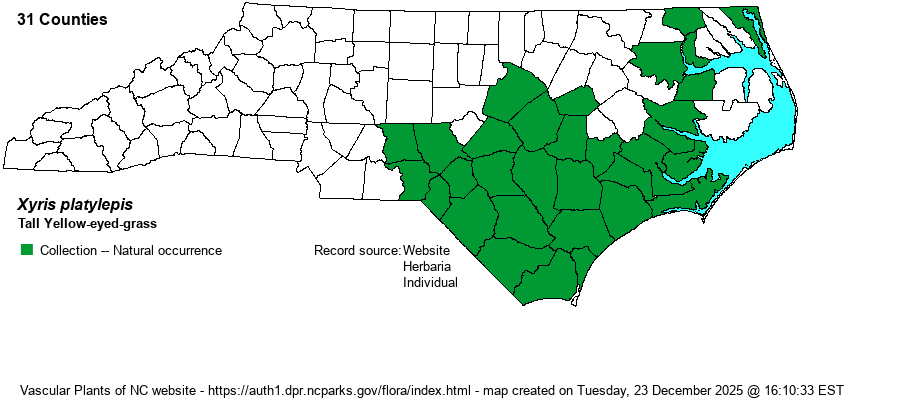| Author | Chapman | |
| Distribution | Coastal Plain and Sandhills; absent from the Outer Banks and barrier islands, and scarce in the northern part of the province. Locally in the southeastern portion of the Piedmont.
Coastal Plain, southeastern VA to southern FL and southeastern LA; western LA and eastern TX. | |
| Abundance | Infrequent to frequent in the central and southern Coastal Plain and Sandhills, but rare to uncommon in the northern third of the province. Rare in the Piedmont. | |
| Habitat | Perennially wet blackwater streamheads and ecotones, wet Longleaf Pine savannas, pocosin ecotones, drawdown shores of impoundments and beaver ponds; usually associated with active seepage. | |
| Phenology | Flowering and fruiting Late July-September. | |
| Identification | Tall Yellow-eyed-grass is robust, the scapes 1.5-3 feet tall and leaves 7-15 mm wide. Scapes and leaves are sinuous or twisted, but not as tightly as in Carolina Yellow-eyed-grass (X. caroliniana). Leaves are pale creamy or brownish basally. Lateral sepals are shorter than the scales, their margins irregularly cut. Coastal-plain Yellow-eyed-grass (X. ambigua) is closely similar but its stem and leaves are not twisted. | |
| Taxonomic Comments | None
Members of Xyris are easy to identify to genus, but can be a challenge to identify species. Careful observation of a few features with a hand-lens is usually sufficient. Close attention must be paid to the flowering head, which is composed of overlapping brown scales. Immediately behind each scale are two brown "lateral sepals"; the margins of these may be feathery or irregularly lacerate (cut into narrow segments) or finely cut into short, comb-like prickles. Lateral sepals may be hidden or a bit longer than each scale. The flowers themselves are usually of little diagnostic value, other than time of flowering -- morning vs. afternoon. Seed size and ornamentation can also be useful characters, but require a dissecting scope to see well. Note also whether leaves and scapes (stems) are twisted and the color of the basal portion. All species have 2-ranked leaves, but in some species the leaves are arranged in a broad, fan-like shape. Finally, note the leaf and stem surface texture -- whether smooth of with little pale bumps. See Godfrey & Wooten (1979) for detailed descriptions and drawings. | |
| Other Common Name(s) | Twistleaf Yellow-eyed-grass, Broad-scale Yellow-eyed-grass | |
| State Rank | S3S4 [S4] | |
| Global Rank | G5 | |
| State Status | | |
| US Status | | |
| USACE-agcp | OBL link |
| USACE-emp | OBL link |

